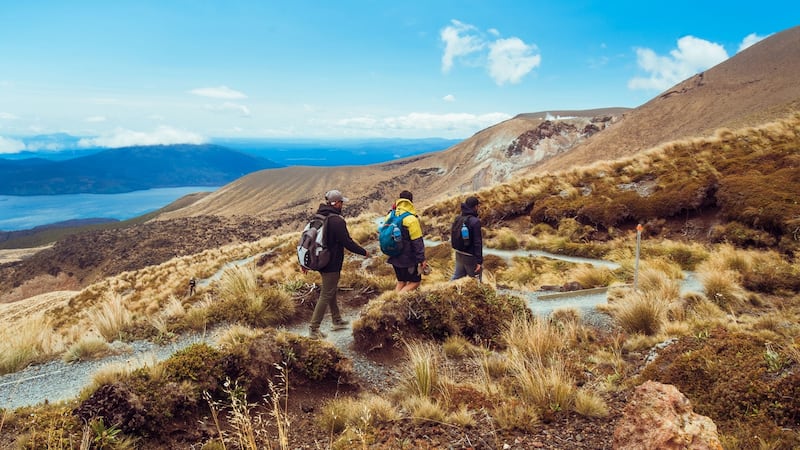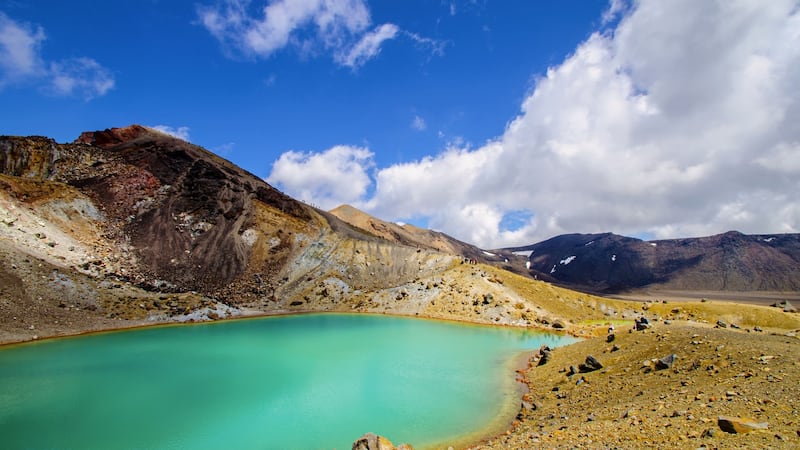The warning sign at the Devil’s Staircase confirmed this was a serious hike.
STOP: Are you really prepared to continue? Have you considered the weather, your equipment, and your fitness?
I was about 90 minutes into the Tongariro Alpine Crossing, and the 20km, nine-hour trek was about to get difficult. My excitement about the possibility of completing this bucket list goal was tempered by apprehension and uncertainty about what lay ahead.
Before leaving Ireland for New Zealand, I had questioned my ability to complete this trek. I emailed two companies which arrange guided walks. I felt the need to tell them that, though I was an experienced trekker, I was 72 and a slow downhill walker.
I received the following replies:
“As a self-professed slower person it is advisable to book a private guided trip, slowing down others on the downhill can be especially frustrating.”
The sun rising over Mount Ngaruahoe dominated the skyline – Mount Doom to Lord of the Rings fans
The second reply was more encouraging, and the one I opted for.
“You do not need a guide, the track is very well marked, and you sound more experienced and fitter than many who complete this hike.”
What they didn’t mention was the “many” I was more experienced than were mainly international backpackers in their 20s, or early 30s.
I took the 5.30am shuttle bus from Taupo to the starting point of the trek. There was an air of excitement as my fellow trekkers set off at a brisk pace. Several of them were poorly equipped for an Alpine environment, where changeable weather could bring wind, rain and cold throughout the day. T-shirts, shorts and trainers were common, but youth was on their side. I had packed for all conditions, and throughout the day I went from woolly hat, gloves and three layers of clothing to shorts and T-shirt.
Sympathy and admiration
My slow, steady pace meant that many people passed me, greeting me with a mixture of sympathy and admiration. I knew from experience that I would meet several of them later, as they tired, and the trail got more difficult.
The first hour was a relatively easy walk up gently rolling hills through the glaciated Mangatepopo Valley, bounded by a lateral moraine. I was immediately struck by the loveliness of the landscape, a flower garden of colourful alpine plants, with clumps of tussock grasses, large mountain daisies and mosses, delicate plants flourishing in a harsh environment.

The sun rising over Mount Ngaruahoe dominated the skyline – Mount Doom to Lord of the Rings fans.
The trek became more challenging approaching the Devil’s Staircase – a steep climb of 370 steps to the South Crater. Plant life was limited on rough tracks of ancient and modern lava flows. It was encouraging to look back down the Mangatepopo Valley to see how far I had come.
The scramble up the Red Crater Ridge was the most strenuous part of the trek, and turning back was not an option. I recalled the advice of my mentor – slow, short, steady steps, and no stopping. The ridge was steep and narrow, exposed to high winds, with vertigo-inducing drops on either side. The trail was not well formed, with loose rocks and gravel underfoot.
I had high expectations. And I wasn't disappointed
I saw some very nervous walkers hanging on grimly to a steel support chain to avoid slipping. No one was passing me on that section. A young Indian lady offered me her hand on a particularly tricky bit, and though I could have managed fine, I gladly accepted her kindness.
The climb to the summit left me momentarily breathless, and I was rewarded by a sight I shall remember as one of the most breathtaking I have ever seen on a mountain. An unobstructed view that included the Red Crater, the Oturere Valley to the east, the Emerald Lakes below, and beyond them the shimmering Blue Lake above the Central Crater.
The calm, cool, blue-green lake waters belied the explosive violent eruptions which created them. I imagined this was the scene which enthused National Geographic to rate Tongariro Alpine Crossing as one of the top 10 one-day hikes in the world.
There was a short difficult descent to the Emerald Lakes and Central Crater on loose rocks and scree. Here, people were slipping and sliding, with the odd person taking a tumble and hurting their pride. The steam rising from the ground in many places, and the sulphurous smell of rotten eggs, indicated that I was in an active volcanic part of the trail.

I stopped for a rest, a snack, and photographs, but not for too long, as I was only at the half way point, and I was worried about the 4pm deadline to catch the return bus. I crossed the Central Crater before climbing to the Blue Lake. This lake is tapu (sacred) to the Maori people and it is disrespectful to touch, eat or drink around its shores. Looking back at the hazardous descent from the Red Crater summit brought a smile at my achievement in negotiating it without incident.
Volcanic eruption
The trail wound around the walls of the Central Crater and I began the long zigzag descent down the Rotopaunga Valley, passing the Ketetahi Shelter. The hut is no longer used for overnight accommodation following damage from the 2012 volcanic eruption at Te Maari crater, which spewed ash kilometres into the sky, and rained rocks down on the shelter.
This is an active Volcanic Hazard Zone, with billowing funnels of steam venting from the crater, and a warning sign advising quick movement through this section of the trail. Lake Taupo in the distance fills the caldera left by a massive volcanic eruption 26,500 years ago, when the effect on the skies were seen from Rome to China. Tongariro’s dynamic landscape, combining beauty and violence in the same place, is a reminder that nature’s cataclysmic events could happen again.
As I continued the steep decent, there was a notable change in vegetation from volcanic gravel to lush mountain plants and grassy hillsides, down to bush and forest at the end of the crossing.
When I read the Tongariro Alpine Crossing described as “New Zealand’s best one-day hike”, I had high expectations. And I wasn’t disappointed. There was an added sense of achievement in doing it alone, which allowed more time for reflection on how lucky I was to be in this wondrous place. There was also a sense of camaraderie and fun, with the occasional words of support and sympathetic glances from strangers. Including a round of applause from a group of five Asians upon my arrival at the Red Crater summit.
Why did I do it? Because it’s hard, and to hold back “bent old age” a little longer. Once started, I never really doubted my ability to complete the trek, though as a “self-professed slower walker” I had some concerns about the 4pm return bus, which I made with only minutes to spare.
In the end, the best reason of all for doing it was the reason we choose to do many things. For the sheer joy of it.










